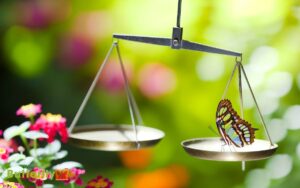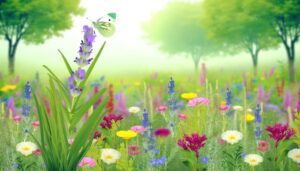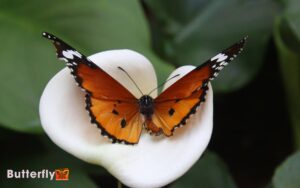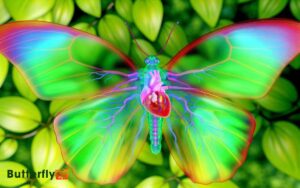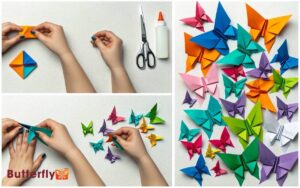How Does A Butterfly Pollinate? Exploring the Process!
Butterflies pollinate flowers through a systematic process. Using their chemoreceptor-laden legs, they detect nectar and collect pollen.
Their proboscis, specially adapted for extracting nectar, gathers pollen that adheres to it and their legs. When a butterfly moves to another flower, it transfers this pollen, enabling cross-pollination.
Butterflies prefer brightly colored, tubular-shaped flowers and work primarily during the day, guided by their keen vision. Their scales and hairs efficiently gather pollen, aiding in plant reproduction.
Although less effective than bees, their role is essential for ecosystem stability. To understand more about butterfly behaviors and impacts on biodiversity, continue exploring.
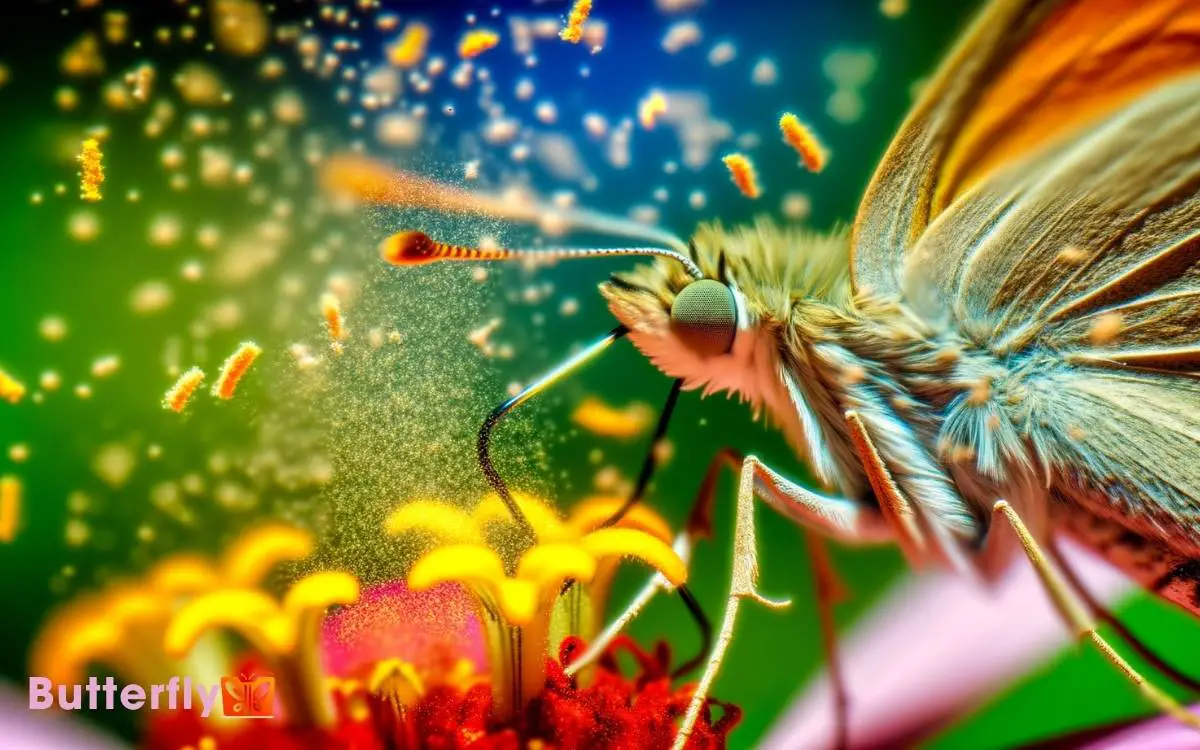
Key Takeaways
Butterfly Anatomy and Pollination
A butterfly’s anatomy, particularly its proboscis and legs, plays a crucial role in the pollination process.
You’ll notice that the butterfly’s legs are equipped with tiny sensory hairs known as chemoreceptors. These allow the butterfly to detect the presence of nectar and pollen on flowers.
As a butterfly lands on a flower, its legs brush against the anthers, collecting pollen grains. The proboscis, a long, coiled tube, is used to extract nectar, providing the energy necessary for flight.
During this feeding process, pollen grains adhere to the proboscis and legs. When the butterfly moves to another flower, these pollen grains are transferred, effectively cross-pollinating the plants.
This intricate anatomical design ensures efficient pollination, fostering biodiversity and plant reproduction.
Role of the Proboscis
The proboscis, a specialized feeding structure, plays a pivotal role in the pollination process by allowing butterflies to access nectar deep within flowers. This elongated tube uncoils to reach into the floral nectaries, ensuring efficient nectar extraction.
As the butterfly feeds, pollen adheres to its body, facilitating cross-pollination when it visits subsequent flowers. The proboscis’s design exemplifies evolutionary innovation, enabling butterflies to exploit a diverse array of floral resources.
| Component | Function |
|---|---|
| Tip | Nectar absorption |
| Base | Attachment to the head |
| Length | Reaches deep nectaries |
| Flexibility | Maneuverability within flowers |
| Coiling Mechanism | Storage when not in use |
Understanding the proboscis’s role underscores its importance in the intricate dance of pollination, promoting genetic diversity across ecosystems.
Flower Preferences
When selecting flowers, butterflies exhibit distinct preferences influenced by factors such as color, shape, and nectar availability. You’ll notice they’re particularly drawn to bright hues like red, purple, and yellow, which are easily spotted from a distance.
They favor tubular-shaped flowers that match their proboscis, facilitating efficient nectar extraction. The importance of nectar is vital; butterflies seek flowers with abundant, easily accessible nectar, ensuring they receive enough energy for flight and reproduction.
Observing these preferences, you can innovate by designing gardens or agricultural fields that attract butterflies, enhancing pollination efficiency. Prioritize planting a variety of brightly colored, tubular flowers with high nectar yields.
This methodical approach not only supports butterfly populations but also boosts the health and productivity of your ecosystem.
Pollen Transfer Mechanism
When you observe a butterfly’s feeding process, you’ll notice it uses its proboscis to extract nectar, coming into contact with pollen.
Pollen grains adhere to various parts of the butterfly’s body, including its legs and proboscis, through electrostatic forces and surface structures.
As it moves from flower to flower, these interactions facilitate the transfer of pollen, aiding in plant reproduction.
Butterfly Feeding Process
Butterflies employ their proboscis to sip nectar from flowers, during which pollen grains adhere to their legs and bodies, facilitating the transfer of pollen between blossoms.
As you observe, the butterfly’s proboscis unfurls into a slender tube, allowing for precise nectar extraction. This process isn’t just about feeding; it’s an intricate dance of co-evolution.
Each visit to a flower results in subtle pollen deposition, contributing to cross-pollination. The butterfly’s movements are deliberate and repetitive, optimizing nectar intake while inadvertently collecting and transferring pollen.
This dual function of feeding and pollination exemplifies nature’s efficiency. You’ll marvel at how such a delicate creature plays an indispensable role in maintaining biodiversity and promoting the reproductive success of flowering plants.
Pollen Attachment Methods
By utilizing specialized scales and fine hairs on their legs and bodies, butterflies efficiently gather pollen grains during their nectar-feeding excursions. These microscopic structures create a high surface area, allowing for maximum pollen adherence.
As you observe a butterfly landing on a flower, notice how its legs and proboscis delicately brush against the anthers, capturing pollen grains.
When the butterfly subsequently visits another flower, these grains transfer to the stigma, promoting cross-pollination. This methodical approach promotes genetic diversity within plant populations.
You’ll find that the intricate design of the butterfly’s anatomy optimizes pollen transfer, making it an innovative natural pollinator. Their precise movements and specialized structures exemplify a remarkable evolutionary adaptation for effective pollination.
Flower Interaction Dynamics
Observing the butterfly’s interaction with a flower reveals a meticulous sequence where its anatomical adaptations facilitate precise pollen transfer. As the butterfly approaches, it extends its proboscis to extract nectar, initiating the pollen transfer mechanism.
You’ll notice three key steps:
- Proboscis Extension: The butterfly unfurls its proboscis to reach deep into the flower, contacting the reproductive structures.
- Pollen Adherence: Pollen grains adhere to the butterfly’s legs and proboscis due to electrostatic forces.
- Subsequent Flower Contact: Upon visiting the next flower, the butterfly transfers the pollen to the stigma, enabling fertilization.
Daytime Pollinators
During the bright hours of the day, various insects, including butterflies, actively engage in the essential task of pollination. You’ll observe butterflies flitting from flower to flower, transferring pollen grains via their proboscis and legs.
Butterflies’ keen vision allows them to locate vibrant flowers rich in nectar. Their feathery scales trap pollen, facilitating cross-pollination as they move.
Optimal temperature and daylight enhance their activity levels, maximizing pollination efficiency. As you study these diurnal pollinators, note their preference for flat, clustered flowers, which provide easier access.
By understanding their behavior and preferences, you can innovate in creating pollinator-friendly habitats. This knowledge is critical for maintaining biodiversity and ensuring the health of ecosystems.
Environmental Impact
You’ll find that butterflies play a pivotal role in maintaining habitat preservation by facilitating plant reproduction. Their pollination activities enhance biodiversity, which supports ecosystem stability.
Additionally, you must consider how climate change impacts butterfly populations, potentially disrupting these essential ecological functions.
Habitat Preservation Importance
Guaranteeing the preservation of butterfly habitats is essential, as their pollination activities have a substantial impact on ecosystem health and biodiversity.
When you prioritize habitat preservation, you directly enhance pollinator efficacy, leading to:
- Increased plant reproduction: Butterflies facilitate cross-pollination, guaranteeing genetic diversity among plants.
- Sustainable food webs: By supporting a variety of flowering plants, you provide food sources for a myriad of species.
- Climate resilience: Diverse ecosystems with robust pollinator networks are better equipped to adapt to environmental changes.
You need to implement conservation strategies such as protecting native plant species, creating butterfly-friendly gardens, and reducing pesticide usage. These actions ensure butterflies continue their critical ecological role, fostering a dynamic, resilient environment.
Biodiversity Enhancement Through Pollination
By supporting butterfly habitats, you don’t just prevent their decline but also greatly boost biodiversity through their pollination activities.
Butterflies exhibit a mutualistic relationship with flowering plants, transferring pollen and facilitating genetic diversity.
This pollination enhances plant reproduction, leading to a variety of flora which, in turn, supports a broader range of fauna.
Observing butterflies, you’ll note their proboscis efficiently accessing nectar, promoting cross-pollination.
Implementing butterfly-friendly strategies, like planting native species and reducing pesticide use, you foster an environment where butterflies thrive. This increases ecological resilience and biodiversity, cultivating a robust ecosystem. Providing shelter, such as nectar-rich flowers and host plants, further enhances butterfly house functionality by offering a safe habitat for feeding and reproduction. Creating windbreaks and maintaining varied plant heights also contribute to a more hospitable environment, ensuring butterfly populations remain stable. These efforts not only support butterflies but also benefit other pollinators, strengthening the entire ecosystem.
Climate Change Implications
Climate change significantly disrupts butterfly pollination patterns, impacting both the insects and the plants they pollinate. Rising temperatures and erratic weather conditions alter blooming periods, creating temporal mismatches.
You can observe the following changes:
- Phenological Shifts: Butterflies may emerge earlier than usual, missing the peak blooming period of plants.
- Habitat Loss: Shifting climate zones force butterflies to migrate, often to areas where host plants are scarce.
- Reduced Biodiversity: Altered ecosystems may lack the necessary diversity of plants, affecting butterfly populations and their pollination efficacy.
These disruptions challenge the intricate relationships between butterflies and flora, necessitating innovative ecological strategies to mitigate the adverse effects.
Monitoring these changes can guide conservation efforts and enhance our understanding of pollination dynamics in a changing climate.
Comparison With Bees
In addition, bees are highly efficient pollinators due to their hairy bodies that trap pollen, while butterflies, with their smooth wings and legs, are less effective.
Bees exhibit floral constancy, visiting the same type of flower repeatedly, which enhances cross-pollination. In contrast, butterflies tend to visit a variety of flowers, potentially reducing their pollination efficiency.
Moreover, bees actively collect pollen for nourishment, ensuring frequent visits to flowers. Butterflies, on the other hand, primarily seek nectar, resulting in less consistent pollen transfer.
These differences highlight the unique but complementary roles both insects play in the ecosystem, each contributing to biodiversity in distinctive ways.
Supporting Butterfly Populations
To support butterfly populations effectively, you should focus on creating and maintaining diverse habitats rich in native flowering plants. This approach promotes robust ecosystems and enhances pollination processes.
- Plant Selection: Choose a variety of native flowering species that bloom at different times to guarantee continuous nectar availability.
- Habitat Design: Create layered vegetation structures, from ground covers to shrubs and trees, to provide shelter and breeding sites.
- Pesticide Management: Minimize or eliminate pesticide usage; opt for organic or integrated pest management practices to safeguard butterflies from harmful chemicals.
Document your observations meticulously to track butterfly population changes and habitat usage. This data-driven approach will help refine your strategies, fostering sustainable butterfly populations and promoting biodiversity.
Importance in Ecosystems
Understanding the importance of butterflies in ecosystems begins with recognizing their role as pollinators, which directly supports plant reproduction and biodiversity.
When butterflies transfer pollen from one flower to another, they facilitate genetic diversity in plant populations. This process is essential for the production of fruits and seeds, sustaining both flora and fauna.
Additionally, butterflies are bioindicators, reflecting the health of ecosystems. Observing their population dynamics and behavioral patterns can reveal environmental changes, guiding conservation efforts.
By pollinating a variety of plants, butterflies contribute to habitat complexity, supporting numerous species.
You can innovate conservation strategies by integrating technology, such as tracking migration patterns with GPS and utilizing AI for data analysis, to better understand and protect these important pollinators.
Conclusion
You’ve seen how butterflies, with their delicate proboscises, flit from flower to flower like living paintbrushes, transferring pollen. Unlike bees, their daytime activity and flower preferences add an important brushstroke to nature’s canvas.
Butterflies play a significant role in sustaining ecosystems, and by supporting their populations, you’re nurturing biodiversity. So, next time you spot a butterfly, remember, you’re witnessing a tiny, yet essential, artist at work in the grand masterpiece of our environment.

